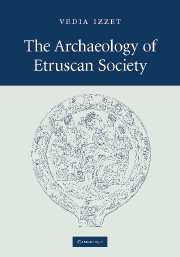Book contents
- Frontmatter
- Contents
- List of illustrations
- Acknowledgements
- List of abbreviations
- Introduction
- 1 Models of change in Etruria
- 2 Etruscan mirrors: reflections on personal and gender identity
- 3 Funerary architecture: the living and the dead
- 4 Sanctuaries: the sacred and the profane
- 5 Domestic architecture: public and private
- 6 Urban form and the concept of the city
- 7 Making Etruscan society: culture contact and (material) culture change
- Bibliography
- Index
7 - Making Etruscan society: culture contact and (material) culture change
Published online by Cambridge University Press: 10 May 2010
- Frontmatter
- Contents
- List of illustrations
- Acknowledgements
- List of abbreviations
- Introduction
- 1 Models of change in Etruria
- 2 Etruscan mirrors: reflections on personal and gender identity
- 3 Funerary architecture: the living and the dead
- 4 Sanctuaries: the sacred and the profane
- 5 Domestic architecture: public and private
- 6 Urban form and the concept of the city
- 7 Making Etruscan society: culture contact and (material) culture change
- Bibliography
- Index
Summary
Introduction
The preceding chapters have emphasised the deliberate nature of the creation of all aspects of material culture. In this way, changes in Etruscan material culture are accorded particular importance in the transformation of late sixth-century Etruria. As a result, such changes cannot be explained simply in terms of a natural evolution towards a more ‘sensible’ form, or in terms of the importation of ‘superior’ models; instead, the changes in Etruscan material forms are characterised by an increased concern with surface as a means of expressing difference. I have argued that the boundaries of physical entities became, in the sixth century bc, condensed to their visible, exterior surfaces, and further, that such physical distinctions echoed ontological ones. Thus, the outer, visible surface of the body, the tomb, the temple, the house and the city became the point at which these entities conceptually began. Surface thus became crucial for the expression of difference and identity in late sixth-century Etruscan material culture.
The importance of surface is not absolute or universal: the treatment of surfaces and boundaries changes over time and space, and is therefore relational. In the areas of Etruscan material culture examined here, for example, the treatment of surface in the late sixth century is more acute than that in the seventh century. The multiplicity of choices and decisions that were made by artisans in the creation of material culture led to objects and spaces that emphasised, to a greater extent than before, boundaries and distinctions through the explicit manipulation of their visible surfaces.
- Type
- Chapter
- Information
- The Archaeology of Etruscan Society , pp. 208 - 235Publisher: Cambridge University PressPrint publication year: 2007



